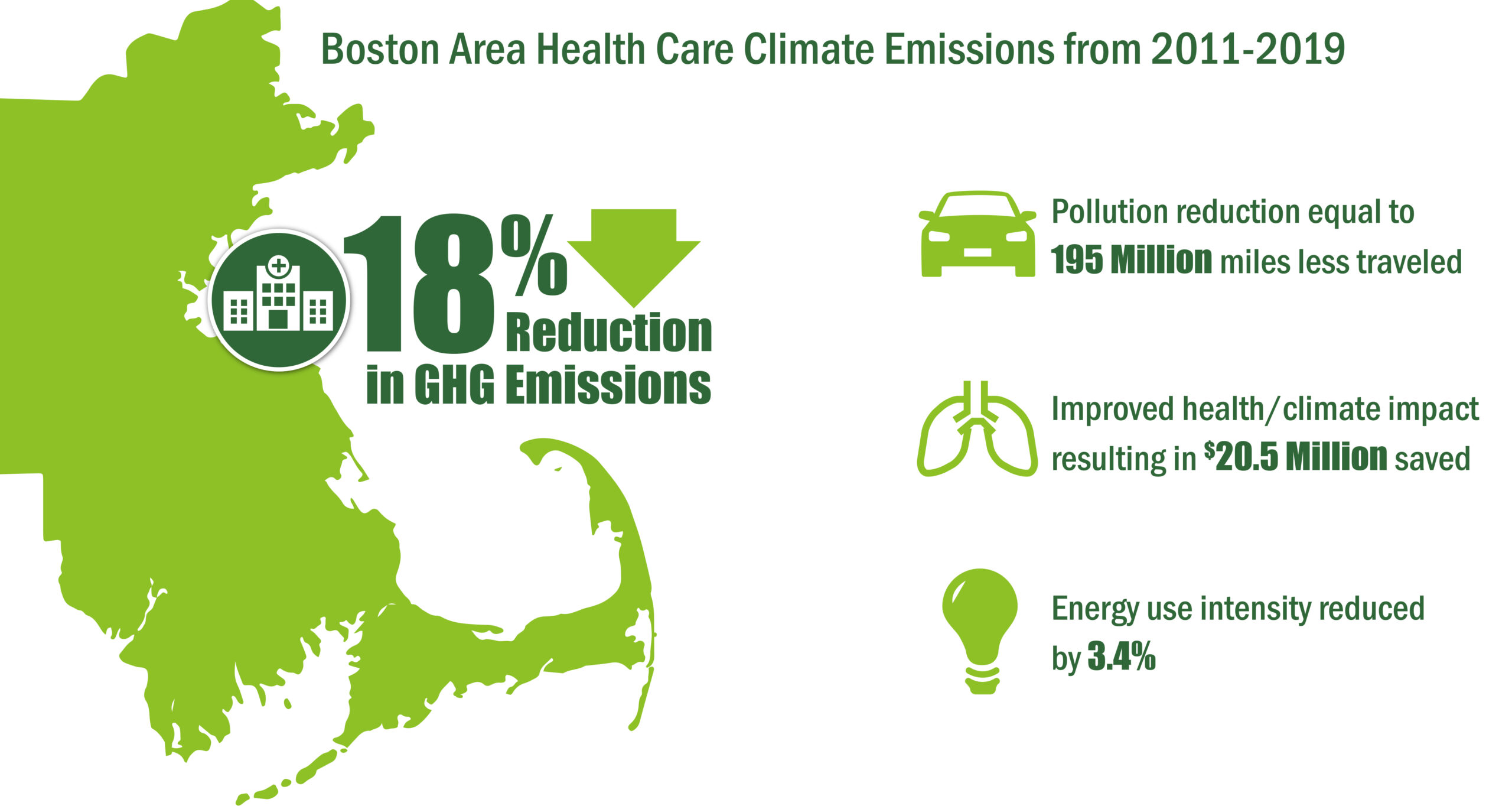Boston’s Healthcare Greenhouse Gas Emissions Cut by 18% in 9 Years Despite Growth

The United States is the world’s highest emitter of healthcare greenhouse gases (GHG), accounting for 27% of the global healthcare footprint.1 Climate change impacts a wide range of health outcomes from asthma and cardiovascular disease to malnutrition and heat-related illness and deaths.2 Healthcare has the opportunity, and obligation, to promote the health of the community they serve and the environment beyond the boundaries of their buildings.
The Strides Made towards Climate Goals
Metro Boston healthcare has been doing its part to reduce climate emissions, reducing GHG by 18% between 2011 and 2019. Hospitals accomplished these emissions reductions despite the addition of 1.9 million square feet of new healthcare buildings and expansions (a 10% increase) and an increase in the number of patients served. This notable progress was achieved largely through renewable energy purchases, installation of new combined heat and power systems, and improvements in energy use intensity.
These findings are the result of the latest, in-depth analysis of energy use data and healthcare metrics performed by EH&E on behalf of Health Care Without Harm. The analysis involved over 40,000 energy and GHG records from 2011 through 2019 covering hospitals in metropolitan Boston with the goal of evaluating progress towards achieving the climate goals shared by the City of Boston and Boston’s Green Ribbon Commission (GRC). The target is to reduce GHG emissions by 50% by 2030, and 100% by 2050.
The pollution reductions achieved by Boston healthcare are equivalent to eliminating 195 million miles traveled by an average passenger vehicle. According to Health Care Without Harm’s Energy and Climate Impact Calculator, the GHG emissions avoided also reduced the social costs – human health and climate change-related impacts – of healthcare’s energy use by over $20.5 million per year.
More so, Boston’s healthcare facilities have become more energy-efficient per square foot of space. Energy use intensity onsite decreased by 9 kBtu/sqft, from 278 to 269 kBtu/sqft, a reduction of 3.4%.
The Key Contributors to GHG Reductions
Since 2011, Boston healthcare organizations have taken steps to considerably reduce their GHG footprints through investment in energy-efficiency projects, renewable energy sources, and combined heat and power (CHP) systems. The transition to renewable energy on the part of several major Boston healthcare institutions is the largest contributor to the reductions to-date.
Shifting away from grid electricity to CHP systems has also contributed to a reduction of GHG emissions. These steps demonstrate a clear pathway to reduce GHG emissions as the City of Boston and the Commonwealth of Massachusetts fulfill their commitments to transition from fossil fuels to renewable electricity.
There is Still More Work to Be Done
From 2011 to 2019, the sector decreased its GHG emissions by approximately 2% a year. While this is good news, these reductions are not yet on a trajectory that would allow the sector to attain the goals articulated by the City of Boston.
The sector is still faced with significant challenges to achieving full decarbonization by 2050. Many Boston hospitals rely on central steam plants and combined heat and power systems. While highly efficient, these systems are powered by the combustion of fossil fuels, primarily natural gas, and there is not yet a clear pathway or timeline to replace or transition to a zero-carbon fuel.
Although not the focus of this analysis, the findings point to biomedical research laboratories, which make up 12% of the city’s health sector’s real estate, as a promising opportunity for future energy efficiency efforts.
The complete findings and trends identified by EH&E’s analysis are detailed in a new report released by Health Care Without Harm on behalf of Boston’s GRC Health Care Working Group.
For expert guidance on effective and safe energy reduction strategies for your facility, contact us today!
- Health Care Without Harm. 2019. “Health Care Climate’s Footprint. How the Health Sector Contributes to the Global Climate Crisis and Opportunities for Action.” Accessed from: https://noharm-global.org/documents/health-care-climate-footprint-report
- Centers for Disease Control and Prevention. 2020. “Preparing for the Regional Health Impacts of Climate Change in the United States.” Accessed at: https://www.cdc.gov/climateandhealth/effects/default.htm
Subscribe
to our blog
"*" indicates required fields





